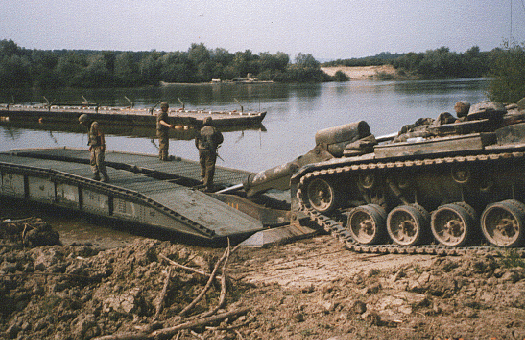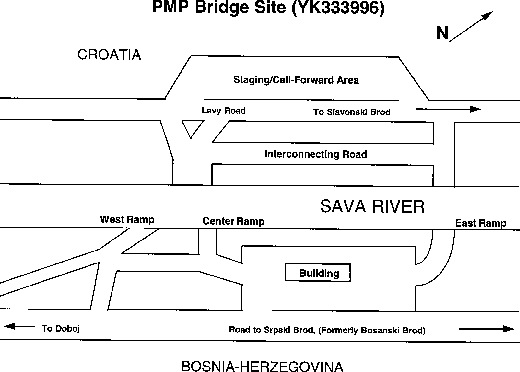
by Captain Anthony G. Reed, 16th and 54th Engineer Battalions
This article was previously published in the August 1997 issue of the Engineer Professional Bulletin.
In May 1996, the two U.S. float bridges in Zupanja were removed from the Sava River, leaving only the repaired fixed bridge in Brcko, in the northeast sector, connecting Bosnia-Herzegovina to Croatia. To save several hours of driving time, Task Force Eagle (1st Armored Division +) tasked units to develop a crossing site to link Slavonski Brod, Croatia, with Srpski Brod, (formerly Bosanski Brod), Bosnia-Herzegovina. The new bridge site would improve efficiency for the Nordic/Polish (NORDPOL) Brigade's convoys and help set the stage for the redeployment of the Implementation Forces (IFOR).
This article describes the crossing site mission, which was one of many where engineer units worked together to provide a wide range of engineer support to Task Force Eagle during Operation Joint Endeavor.

The Mission
A Hungarian engineer (PMP) float bridge company was tasked to emplace the bridge, and the 16th Engineer Battalion (Corps) (Mechanized) was tasked to clear and proof three boat ramps where the bridge was to be emplaced. The 16th Battalion's B Company organized and controlled all required assets and coordinated with the NORDPOL Brigade and Bosnian Serb engineers to have the Serbs clear their mines before we proofed the area. Based on reconnaissance, we took the following equipment and personnel:
On the southern shore of the river, the west, center, and east ramps were potential crossing points. Records showed that minefields were on or directly beside all three ramps. The center ramp was our first priority, since no mines were on it. We only needed to construct a 30-meter road to connect the ramp to an existing parking area, which would serve as a holding area for future convoys. The west ramp was our second priority, because it had the most gradual slope and was twice as wide as the others.
At the proposed crossing site, we occupied an abandoned fuel tank farm that consisted of one large building and a huge, fenced parking lot. The building was wrecked and uncleared, so we set up tents to live in and secured the area.
The Hungarian float bridge company was across the river in Croatia. Since Croatia is a nonaggressive state, the Hungarians built the bridge there and secured it parallel to the river bank.
The Hungarian float bridge is the Former Warsaw Pact PMP bridge. It is similar to our assault float bridge (AFB) except that the PMP is steel, while the AFB is aluminum. In addition, the PMP can be split in half lengthwise to double the span for one-way traffic, although this significantly reduces the bridge's military load class. The PMP is assembled in the water very much like the AFB.
Proofing
We began proofing with the Panther near the center ramp, which was in a field about 30 meters southwest of the parking lot. The entire field had to be proofed because of the way the Hungarians had anchored the bridge. Rather than use an overhead anchorage system, they had tied cables from the bridge to bridge trucks parked on the shore.
The Panther's brakes weren't strong enough (via remote control) to prevent it from slipping into the river while proofing the ramps, so we used the M88 recovery tank as a control vehicle at the top of the ramp and connected the Panther to it with cables. We eased the Panther about halfway into the water with the cables, then reeled it back. Maintaining substantial overlap, we moved the Panther over slightly and repeated the process.
We proofed the field several times to ensure that it was clear of mines. The only area we didn't proof initially was directly to the right of the ramp, because minefield records indicated that 12 TMA-4 antitank mines were there. Our orders were to wait for the Serbian engineers to destroy those mines. They placed a small block of explosive with a blasting cap and time fuse next to each mine and blew them in place.
The Serbs cleared the center and west ramps, and we cleared the east ramp. We visually located three TMM-1 antitank mines and one PMR-2A antipersonnel mine. We placed half a block of C4 next to each and blew them one at a time.
The Panther could proof in all the areas where mines were destroyed, so we didn't need the miniflail. However, in mud such as that encountered near shore, the Panther's desert-type mine rollers tended to push a mine around rather than trap it between two hard spots and detonate it. We found a TMA-5 antitank mine in the mud where the Panther's rollers had stopped without detonating it. Later, as we reeled the Panther out of the water, its track picked up another mine embedded in mud. Most of the mud and the mine fell onto the ramp. But when we moved over to make another pass, the Panther's track solidly wedged the mine against the concrete ramp, causing it to detonate. Damage to the Panther included the following:
Four days later, the Panther was repaired to a fully mission-capable status, and we continued proofing.
In areas where we couldn't proof mechanically, we used mine detectors and probes and discovered three antipersonnel mines. During proofing, our soldiers wore their flak vest and BASIC (body armor set, individual countermine), which is Kevlar-lined protective pants, protective overshoes, and a reinforced face shield.
The Swedish explosive ordnance disposal (EOD) team, with its mine dog and bomb dog, marked the cleared paths through minefields and cleared the building in the parking area and a concrete bunker near the center ramp. They used colored fluorescent spray paints and wooden stakes to mark cleared footpaths through the minefields. Each color meant something different; for example, blue may mean that an area had been cleared by a mine dog, while red may mean it was probed by hand. This is a great technique because the proofing results are highly visible.
The Finnish EOD team removed small trees and brush from under the water to ensure a clear path to the west ramp. The team packed explosives into a U-shaped channel of aluminum, in much the same way as we make an expedient bangalore torpedo with a U-shaped picket. Then they floated out near the trees on a rubber raft and emplaced the charges in the water. Initially, they placed the channels of explosives vertically beside the trees, facing the trunks. Later, when most of the tree tops were gone but some roots remained, they laid the charges into the river bed and gently tamped them into the mud. This was extremely effective.
Bridging
When the center ramp was cleared and proofed, we emplaced the float bridge. Security was critical because the bridge site had to be protected from terrorist activity from both the southern and northern shores. It was the first time in four years that a bridge had been emplaced in this sector. Sabotage and a Serbian crossing into Croatia were two of our biggest concerns. Therefore, we reinforced the fence around the parking lot on the south side with triple-standard concertina wire and several manned gates. The north side was manned by Croatian police and Hungarian engineers. B Company engineers guarded the gates for the first five days until a Swedish mechanized infantry platoon assumed responsibility.
Although B Company engineers initially controlled traffic across the bridge, this responsibility soon was transferred to the 317th Rear Area Operations Center (RAOC), a small but extremely effective team. Fortunately, we worked well with them, because much of the traffic over the bridge was engineer vehicles.
We had to clear and proof the east and west ramps after the bridge was in place. We decided to do this while traffic crossed the bridge and close it only to detonate charges. However, it became increasingly difficult to coordinate all the proofing and demolitions with the large volume of traffic and the number of visitors to the site. Then demolition operations became more complex as the Serbs and the Finns also began clearing. Again, the 317th RAOC worked with us to coordinate demolitions so as to maintain the safety of everyone involved.

Further Proofing
As the river receded, additional proofing was necessary on the newly exposed shore next to the ramps. We had to ensure it was safe in case a soldier disembarked near the bridge entrance or exit.
Explosions off the west ramp by the Finnish EOD team caused an underwater mine near the center ramp to detonate. So the Hungarians wanted us to proof with the Panther again, especially on the center ramp. We placed an armored vehicle-launched bridge (AVLB) over the water, then walked onto the bridge and lowered charges into the water on each side of the ramps. We detonated four such charges, but there were no more sympathetic detonations.
Horizontal Construction
Since we controlled traffic across the bridge, we could combine the staging areas and call-forward areas.
North Side Layout. The north side of the crossing site needed an area to stage and call forward vehicles waiting to cross the river. Access to the site was via a narrow road surrounded by woods on top of an earthen levy. Three ramps, called the west, center, and east ramps, corresponded with those on the southern shore. The west and center ramps on the north side were so close together that a bridge could span from the southern center ramp to either of them (see figure). The 2d Platoon of the 535th Combat Support Equipment Company cleared and constructed a staging/call-forward area just north of the levy road, since the area had a separate entrance and exit. The platoon also connected all three northern ramps with a road wide enough to include a staging area for priority traffic.
South Side Layout. On the south side, the abandoned fuel tank farm, with access roads constructed by the 535th, could be used for a staging/call-forward area. Several enormous petroleum product and storage plants with extensive road networks and parking lots about three to five kilometers to the northeast would facilitate at least two staging areas.
Ramp Improvements. As the river continued to recede, it left a significant drop-off where the ramps ended. A platoon from the 535th hauled in large quantities of fill and lengthened the ramps so the float bridge's length could be adjusted to the water level.
Clean-Up Operations
After the Finns blew charges in the water to clear the foliage, they brought in an excavator to clean up roots and debris. To allow them to reach out farther across the water, we laid out the AVLB so they could move the excavator onto the bridge. This was the second time we had used the AVLB in a nontraditional role.
The Finns had a bucket loader with a revolving street broom attachment, which we used to sweep the large parking lot. It is a very efficient and useful device.
Lessons Learned
Most important, we learned that engineers must maintain a wide variety of equipment to accomplish the myriad of tasks expected of them. This can be accomplished in two ways:
We also learned that there is a continued requirement for better countermine equipment. The Panther with its desert rollers was helpful, but it often failed to detect mines. Until technology provides us with that "ultimate" piece of countermine equipment, we must continue to use every tool available to reduce and eliminate the mine threat in every situation we encounter.